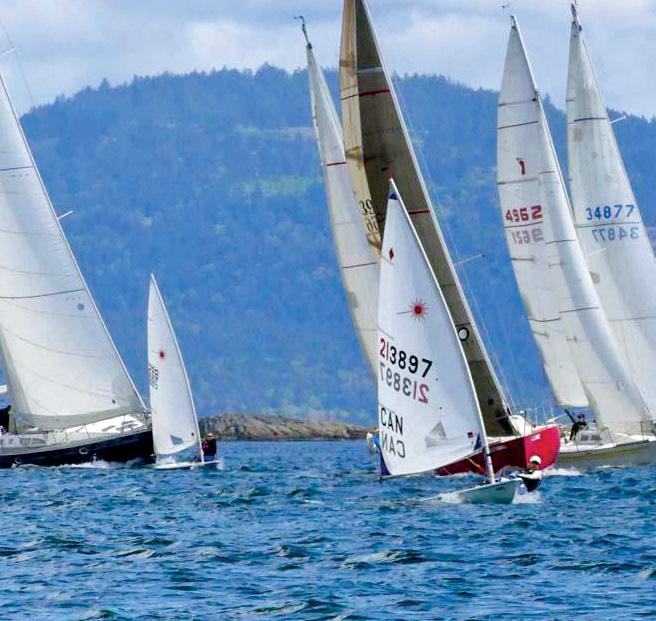
3 minute read
Racing Rules with Charlie Macaulay
from June 2020 48° North
by 48° North
KEEPING Clear
Does Yellow Keep Clear?
Wind – 12 kts.
C
C B
B A A RC
What Does it Mean to Keep Clear?
Rules 10, 11, 12, and 13 are the basic Racing Rules of Sailing (RRS). Rules 10, 11, and 12 also apply when cruising since they are incorporated into the International Regulations for Prevention of Collisions at Sea (COLREGs) as Rules 12 and 13. All of these rules require a boat to keep clear of another (or “keep out of the way” in COLREG terms).
So, what does it mean to keep clear? The RRS provides a concise definition. First of all, a boat keeps clear of a right-ofway boat when the right-of-way boat “can sail her course with no need to take avoiding action…” In other words, the right-ofway boat need not alter her course to prevent contact with the other boat. That’s pretty simple and easily understood.
But there is a big ‘AND’ right after that. It says that when boats are overlapped, the keep-clear boat must stay far enough away from the right-of-way boat that the right-of-way boat can “change course in both directions without immediately making contact.”
Note the maneuvering part of the definition applies to the right-of-way boat, not the keep-clear boat. So if you’re in a Melges 24, you can get pretty close to weather of an old 6 Meter, but the old 6 Meter needs to stay further away from the Melges 24. It may not seem fair in some respects, but that’s reality. If you’re sailing in a boat that has responsiveness limitations, you need to take avoiding action earlier than if you’re in a sport boat. Similarly, a semi-truck needs to act earlier to avoid a collision than a motorcycle.
RRS 11 requires an overlapped windward boat to keep clear of the leeward boat. This rule is most often broken as boats approach the start line—especially dinghies. We have all seen the crowds at the favored end where boats are a bit early and luffing sails to stay below the line. Since the boats are not making way at that point, most boats are complying with the requirement to keep clear. A boat that is not making way can’t turn quickly, so moving the helm results in minimal change in direction. But the instant sails are sheeted in at the gun, the situation changes completely. As an on-the-water judge, it is very rare to not see a violation of RRS 11 at a competitive dinghy start.
One of the unwritten rules of sailing is that we tolerate this condition as long as it does not hurt our competitive position. This means that when the windward boat is behind the leeward boat, there is very rarely a protest as long as there is no contact. But if you are windward, close aboard, and get ahead of a leeward boat at the line, watch out!
Another common situation with boats maneuvering at the start (usually with a less crowded line) is shown in the diagram above. We see two J/109s sailing along overlapped for many boat lengths. At Position C, Yellow’s port quarter is less than 1 foot from Blue’s starboard bow. Did Yellow keep clear?
Yellow can claim that Blue changed course at Position B and did not allow time to keep clear per RRS 16. But when did Yellow’s obligation to keep clear begin? It began at Position A, when the overlap was first established. So any maneuver Yellow made (or didn’t make) that allowed the boats to get closer than at Position A is on her. If Blue protests with these facts, she will prevail.
Charlie Macaulay owns the Farr 39 ML “Absolutely”, is a US Sailing Judge and Judge Instructor, and is a member of the Board of PHRF-NW.









